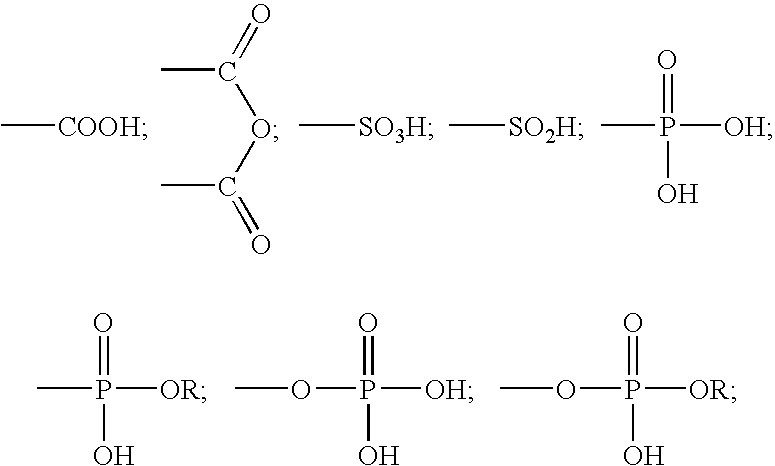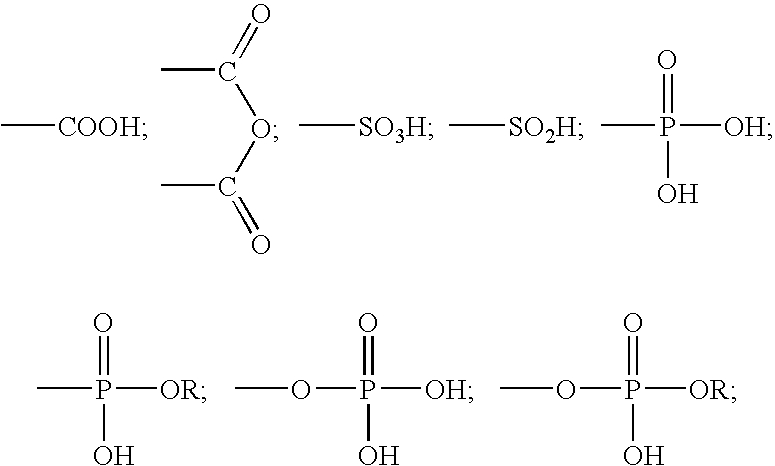Two-part self-adhering dental compositions
a self-adhering, dental composition technology, applied in the direction of prosthesis, group 5/15 element organic compounds, impression caps, etc., can solve the problems of reducing the efficiency of the restorative procedure. , to achieve the effect of reducing the difficulty of combining ingredients and simplifying the restorative procedur
- Summary
- Abstract
- Description
- Claims
- Application Information
AI Technical Summary
Benefits of technology
Problems solved by technology
Method used
Image
Examples
example 1
Comparative Example
[0066]The following adhesive cement formulas comprising base paste (B-1) using DHEPT as an activator and catalyst pastes (C-1 & C-2) using benzoyl peroxide (BPO) as catalyst were made for comparison purposes. Acidic monomer GDM-P was incorporated in the catalyst paste C-2 while GDM-P was replaced with non-acidic monomer GDM in catalyst paste C-1.
[0067]In making all the pastes in this and the following examples, first all the monomers and any ingredients soluble in the resin mixture were mixed together to make a homogeneous liquid mixture, and the then the fillers (TS-530, ST-OX-50, Sr / Zn FAS Glass, or Barium Glass) were blended into the liquid mixture to make the paste. For testing set time in all the examples, the base and catalyst pastes were mixed in 1:1 ratio (weight).
[0068]
B-1BisGMA8.65UDMA7.22PEG-400 DMA4.33ETMPTA2.89HEMA5.77CQ0.09MEHQ0.014DMAPE0.13DHEPT0.41TS-5303.00ST-OX-504.72Sr / Zn FAS Glass62.78C-1C-2BisGMA6.566.56GDM16.40—GDM-P—16.40HEMA6.566.56ETMPTA3....
example 2
[0070]A catalyst paste (C-3) similar to C-2 in Example 1 was made by replacing BPO with cumene hydroperoxide (CHP) as the catalyst.
[0071]
C-3BisGMA6.45GDM-P16.13HEMA6.45ETMPTA3.23BHT0.05CHP1.19TS-5302.00ST-OX-503.22Barium Glass61.28
Two base pastes (B-2 and B-3) similar to B-1 in Example 1 were made by replacing DHEPT with 1-acetyl-2-thiourea (ATU) and 1-(2-pyridyl)-2-thiourea (PTU) respectively.
[0072]
B-2B-3BisGMA8.658.65UDMA7.227.22PEG400DMA4.334.33ETMPTA2.892.89HEMA5.775.77CQ0.090.09MEHQ0.0140.014DMAPE0.130.13ATU / PTU0.41 (ATU)0.41 (PTU)TS-5303.003.00ST-OX-504.724.72Sr / Zn FAS Glass62.7862.78
The combination of B-2 and C-3 had an initial set time of 4′21″, and the combination of B-3 and C-3 had an initial set time of 3′28″. The catalyst paste C-3 was then subjected to accelerated aging at 37° C. and the set time was tested every week with respective bases (B-2 and B-3) that were stored at ambient temperature.
[0073]Set time tested against catalyst C-3 (stored at 37° C.)
[0074]
Base B-2 (A...
example 3
[0075]Two more catalyst pastes (C-4 and C-5) were made using p-methane hydroperoxide (MHP) as the catalyst. C-4 contained no water, while 1.51% of water was introduced into C-5.
[0076]
C-4C-5BisGMA6.346.03GDM-P15.8215.08HEMA6.346.03ETMPTA3.173.02BHT0.050.05Water—1.51MHP (55% active ingredient)1.781.78TS-5302.002.00ST-OX-503.223.22Barium Glass61.2861.28
The base B-3 of Example 2 was used to test the set times of catalyst pastes C-4 and C-5. The initial set time of freshly prepared pastes and set times after aging for various times are listed in following table. Similar to Example 2, the base was aged at room temperature, and the catalyst pastes were aged at 37° C.
[0077]
Set TimeC-4C-5Initial3′36″4′05″1 week3′49″4′18″2 weeks4′53″3′42″3 weeks6′40″4′36″4 weeks6′52″5′10″5 weeks——6 weeks7′12″6′30″
Again, shelf-stable adhesive cement systems were obtained utilizing self-cure initiator system comprising PTU and MHP (a hydroperoxide). Incorporation of water made the catalyst paste (C-5) slightly ...
PUM
| Property | Measurement | Unit |
|---|---|---|
| mean particle size | aaaaa | aaaaa |
| bond strength | aaaaa | aaaaa |
| temperatures | aaaaa | aaaaa |
Abstract
Description
Claims
Application Information
 Login to View More
Login to View More - R&D
- Intellectual Property
- Life Sciences
- Materials
- Tech Scout
- Unparalleled Data Quality
- Higher Quality Content
- 60% Fewer Hallucinations
Browse by: Latest US Patents, China's latest patents, Technical Efficacy Thesaurus, Application Domain, Technology Topic, Popular Technical Reports.
© 2025 PatSnap. All rights reserved.Legal|Privacy policy|Modern Slavery Act Transparency Statement|Sitemap|About US| Contact US: help@patsnap.com



